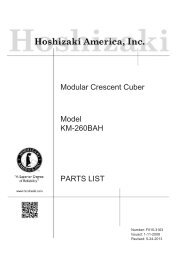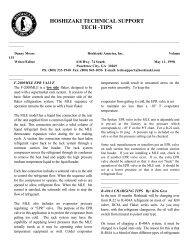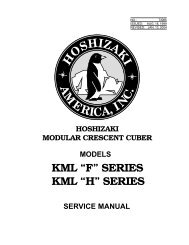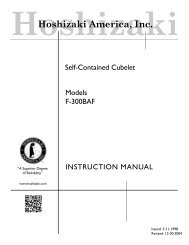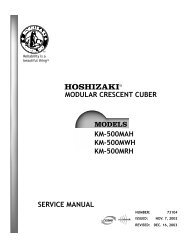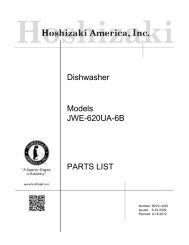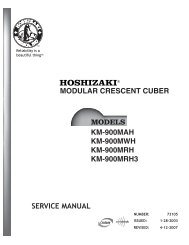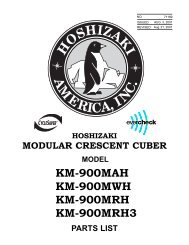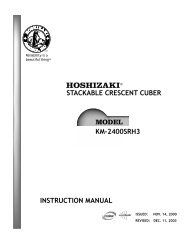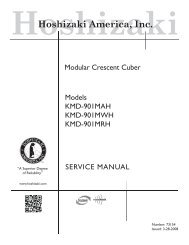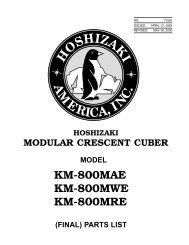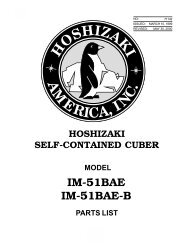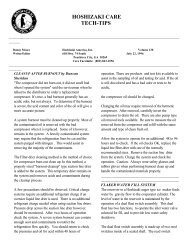Tech Tip 134 - Hoshizaki America, Inc.
Tech Tip 134 - Hoshizaki America, Inc.
Tech Tip 134 - Hoshizaki America, Inc.
Create successful ePaper yourself
Turn your PDF publications into a flip-book with our unique Google optimized e-Paper software.
HOSHIZAKI CARE<br />
TECH-TIPS<br />
____________________________________________________________________________________________<br />
______<br />
Danny Moore <strong>Hoshizaki</strong> <strong>America</strong>, <strong>Inc</strong>. Volume <strong>134</strong><br />
Writer/Editor 618 Hwy. 74 South November 6, 1996<br />
Peachtree City, GA 30269<br />
Care Facsimile: (800) 843-1056<br />
____________________________________________________________________________________________<br />
_______<br />
PROTECTION AGAINST VOLTAGE<br />
FLUCTUATIONS<br />
The <strong>Hoshizaki</strong> KM cuber has built-in voltage<br />
protection. This serves to protect the unit against a<br />
voltage surge or a brown-out situation.<br />
On early model KM’s using a “C” control board, high<br />
voltage protection was accomplished by the use of a<br />
voltage protect relay. Models which have a voltage<br />
protect relay have high voltage protection only. The<br />
relay has a 230 volt coil in parallel with the 115 volt bin<br />
control, power circuit. It’s contacts supply power to<br />
the low voltage control transformer.<br />
If a voltage of 150 volts or more is supplied to this 115<br />
volt circuit,( voltage spike / surge, or a high leg supply<br />
), the relay coil will energize and open the control<br />
transformer circuit. This will remove control voltage<br />
from the board and shut down the unit. When the<br />
voltage returns to normal, the relay de- energizes. This<br />
closes the relay contacts to the transformer circuit.<br />
When control voltage is restored to the board the unit<br />
automatically restarts.<br />
All “Alpine “ control board units have high and low<br />
voltage protection built into the board. They have a<br />
control transformer which will handle a wider supply<br />
voltage range. As you know, a transformer has a<br />
specific ratio of input to output. When the input<br />
changes, the output changes proportionately.<br />
The control board basically monitors the incoming<br />
control voltage. If the control voltage falls in the<br />
established high or low range, the board does not<br />
supply power to the other components to protect them<br />
from damage. When the supply voltage is<br />
restored to the normal range, the correct control voltage<br />
allows the control board to automatically restart the unit.<br />
It is important to note that this built-in voltage protection<br />
has it’s limits. If you are in a location which is known to<br />
have severe voltage problems, additional voltage<br />
protection should be installed.<br />
__________________________________________<br />
__________________________________________<br />
FLAKER TIMER BOARD<br />
The solid state timer board used in <strong>Hoshizaki</strong> Flakers is<br />
a simple electronic sequence timer. In order for the<br />
board to sequence, certain circuits must be closed.<br />
While the wiring varies slightly between models, the<br />
basic circuits are the same.<br />
In order to diagnose a bad timer board, it is necessary<br />
to check these circuits to assure they are operating<br />
properly. If you are trouble-shooting a timer, the first<br />
thing you should check is the in coming control voltage.<br />
All <strong>Hoshizaki</strong> flakers have a 24 volt control transformer.<br />
The output of this transformer is protected by a 1 amp<br />
buss type fuse. Control voltage comes in the timer on<br />
pins 1 & 2. If you do not have 24 volts at pins 1 & 2,<br />
check the transformer and fuse.<br />
Now check for 24 volts across pins 7 & 8. If voltage is<br />
present, the timer board has cycled up which indicates<br />
there is not a problem in the timer board. The problem<br />
is in the gear motor relay circuit. remember that there is
a time delay from the time you turn the unit on to the<br />
time it cycles up completely. this time will be from 1 ~<br />
2.5 minutes, depending on the model of flaker.<br />
In order for the flaker to start up, the reservoir must be<br />
full and both float switches must be closed. This closes<br />
the control circuit to pins 3 & 4. Do not confuse these<br />
pins with the line voltage terminals marked 3 & 4 on the<br />
compressor relay located on the board. You can check<br />
this circuit with a volt meter across the pins or by<br />
placing a jumper across them. If the unit cycles up with<br />
the jumper in place, the board is good and your<br />
problem is in the water relay control circuit.<br />
Next, you should check the bin control circuit at pins 5<br />
& 6. Check for a closed circuit with a volt meter or<br />
place a jumper across them. If the unit cycles up with<br />
the jumper in place, the board is good and the bin<br />
control circuit is the problem.<br />
The last circuit check is across pins 10 & 11. These<br />
pins connect to the gear motor protect relay and will<br />
shut down the unit if the gear motor fails. Check for a<br />
closed circuit with a volt meter or place a jumper across<br />
them. If the unit cycles up with the jumper in place, the<br />
board is good and the gear motor protect circuit is<br />
suspect.<br />
Now that you know that these circuits work together to<br />
allow the timer to sequence up, it should be easier to<br />
diagnose a bad timer board.<br />
__________________________________________<br />
__________________________________________<br />
SERVICE Q & A<br />
Question: The evaporator section is frozen solid. Once I<br />
thaw it, what do I check?<br />
Answer: By Duncan Sheridan You will find that the<br />
main reason for a freeze up is either a dirty evaporator<br />
or low water flow. After de-frosting the evaporators<br />
check to see if the they are dirty i.e.: lime-scale mineral<br />
deposits. Turn the machine on and after the compressor<br />
starts, shut off the incoming water and allow the plates<br />
to dry. After an approximate run time of 2-4 minutes,<br />
switch the unit off and inspect the evaporator plates.<br />
You will find that salt from a water softener can form an<br />
invisible coating on the plates. Care should be taken to<br />
purge a water softener when charging it to eliminate this<br />
possibility. If scale or a salt coating is present, clean the<br />
water system with <strong>Hoshizaki</strong> Scale- Away as required.<br />
Follow the instructions provided on the cleaning label on<br />
the inside of the front cover of the machine.<br />
Verify that the incoming water flow rate is 3GPM<br />
for KM 250-800 machines, 5GPM for KM-1200-<br />
2400 machines. One technique to check this, is to time<br />
the fill cycle when the sump tank is empty and see if the<br />
tank overflows in 60 ~ 90 seconds or less. If you find<br />
the water flow is reduced, check the external water<br />
filters and replace as needed.<br />
Inspect the water inlet solenoid valve and clean the inlet<br />
screen if necessary. Confirm that the water line size is<br />
of adequate size, ( 3/8” o.d. for KM-250~800 models<br />
and 1/2” o.d. for KM-1200~2400 models ).<br />
After determining the water flow is OK, check the bin<br />
control by placing ice on the bulb. The machine should<br />
shut off in 6-10 seconds. If not, adjust it for proper<br />
operation or replace it as needed. If your machine is a<br />
an “S” model installed on a non- <strong>Hoshizaki</strong> bin, make<br />
sure you have a bin extension<br />
bracket installed. <strong>Hoshizaki</strong> part number 3A0408-01 is<br />
an additional stainless steel extension bracket that is to<br />
be attached to the existing white A.B.S. plastic bulb<br />
bracket. This bracket lowers the ice level inside the bin<br />
to where the last ice drop is able to clear the chute area<br />
into the bin, eliminating ice back-up.<br />
Other areas to check are, is the ice still dropping<br />
into the bin when the unit cycles into the freeze mode? If<br />
so check for cold incoming water temp or low hot gas<br />
flow. Does the inlet water solenoid valve close<br />
completely during the freeze cycle? If not check the<br />
water valve diaphragm and clean or replace diaphragm<br />
or valve as needed. Further testing could include<br />
checking the hot gas valve inlet and outlet temperature<br />
during harvest making sure the valve is functioning. Also<br />
inspect the water pump to be sure it is always running<br />
during the complete freeze cycle. Make sure the float<br />
switch is operating correctly and that it is clean. We
have a freeze-up check list available, if you need one or<br />
have any questions contact the Care Department.<br />
__________________________________________<br />
________________________________________________<br />
__<br />
COMING NEXT MONTH...<br />
1. Cleaning KM Float Switch<br />
2. Alpine Board Dips 7 & 8<br />
3. Service Q & A Volume <strong>134</strong> Page 2



